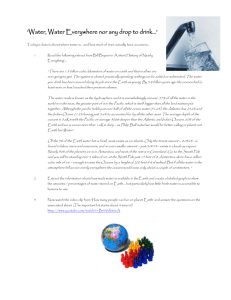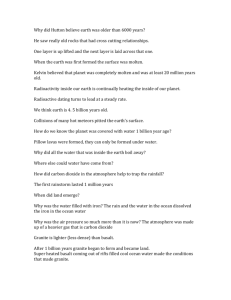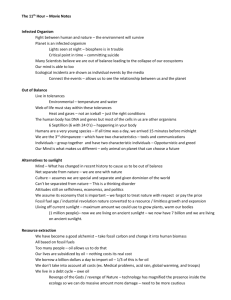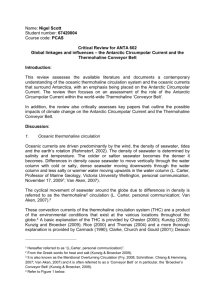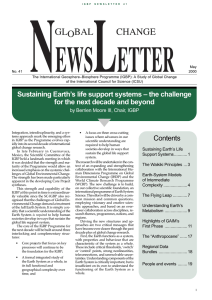Vital organs in the Earth system
advertisement
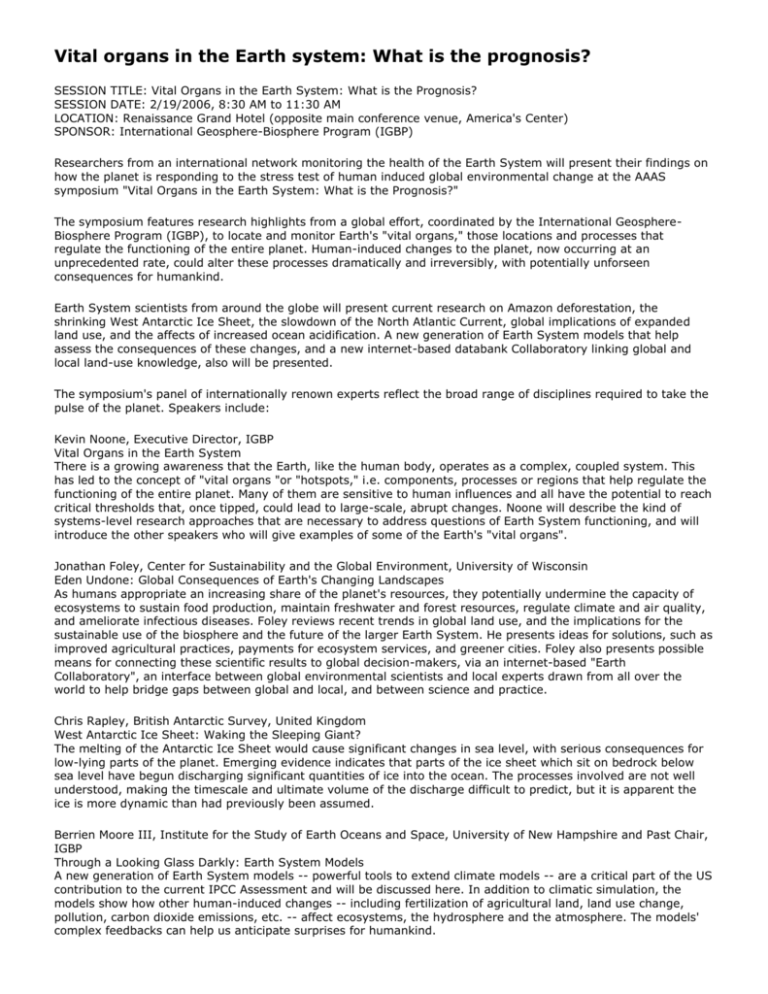
Vital organs in the Earth system: What is the prognosis? SESSION TITLE: Vital Organs in the Earth System: What is the Prognosis? SESSION DATE: 2/19/2006, 8:30 AM to 11:30 AM LOCATION: Renaissance Grand Hotel (opposite main conference venue, America's Center) SPONSOR: International Geosphere-Biosphere Program (IGBP) Researchers from an international network monitoring the health of the Earth System will present their findings on how the planet is responding to the stress test of human induced global environmental change at the AAAS symposium "Vital Organs in the Earth System: What is the Prognosis?" The symposium features research highlights from a global effort, coordinated by the International GeosphereBiosphere Program (IGBP), to locate and monitor Earth's "vital organs," those locations and processes that regulate the functioning of the entire planet. Human-induced changes to the planet, now occurring at an unprecedented rate, could alter these processes dramatically and irreversibly, with potentially unforseen consequences for humankind. Earth System scientists from around the globe will present current research on Amazon deforestation, the shrinking West Antarctic Ice Sheet, the slowdown of the North Atlantic Current, global implications of expanded land use, and the affects of increased ocean acidification. A new generation of Earth System models that help assess the consequences of these changes, and a new internet-based databank Collaboratory linking global and local land-use knowledge, also will be presented. The symposium's panel of internationally renown experts reflect the broad range of disciplines required to take the pulse of the planet. Speakers include: Kevin Noone, Executive Director, IGBP Vital Organs in the Earth System There is a growing awareness that the Earth, like the human body, operates as a complex, coupled system. This has led to the concept of "vital organs "or "hotspots," i.e. components, processes or regions that help regulate the functioning of the entire planet. Many of them are sensitive to human influences and all have the potential to reach critical thresholds that, once tipped, could lead to large-scale, abrupt changes. Noone will describe the kind of systems-level research approaches that are necessary to address questions of Earth System functioning, and will introduce the other speakers who will give examples of some of the Earth's "vital organs". Jonathan Foley, Center for Sustainability and the Global Environment, University of Wisconsin Eden Undone: Global Consequences of Earth's Changing Landscapes As humans appropriate an increasing share of the planet's resources, they potentially undermine the capacity of ecosystems to sustain food production, maintain freshwater and forest resources, regulate climate and air quality, and ameliorate infectious diseases. Foley reviews recent trends in global land use, and the implications for the sustainable use of the biosphere and the future of the larger Earth System. He presents ideas for solutions, such as improved agricultural practices, payments for ecosystem services, and greener cities. Foley also presents possible means for connecting these scientific results to global decision-makers, via an internet-based "Earth Collaboratory", an interface between global environmental scientists and local experts drawn from all over the world to help bridge gaps between global and local, and between science and practice. Chris Rapley, British Antarctic Survey, United Kingdom West Antarctic Ice Sheet: Waking the Sleeping Giant? The melting of the Antarctic Ice Sheet would cause significant changes in sea level, with serious consequences for low-lying parts of the planet. Emerging evidence indicates that parts of the ice sheet which sit on bedrock below sea level have begun discharging significant quantities of ice into the ocean. The processes involved are not well understood, making the timescale and ultimate volume of the discharge difficult to predict, but it is apparent the ice is more dynamic than had previously been assumed. Berrien Moore III, Institute for the Study of Earth Oceans and Space, University of New Hampshire and Past Chair, IGBP Through a Looking Glass Darkly: Earth System Models A new generation of Earth System models -- powerful tools to extend climate models -- are a critical part of the US contribution to the current IPCC Assessment and will be discussed here. In addition to climatic simulation, the models show how other human-induced changes -- including fertilization of agricultural land, land use change, pollution, carbon dioxide emissions, etc. -- affect ecosystems, the hydrosphere and the atmosphere. The models' complex feedbacks can help us anticipate surprises for humankind. Carlos Nobre, Instituto Nacional de Pesquisas Espaciais, Brazil and Chair, IGBP The Amazon and the Sahara: A Tale of Two Ecosystems The impacts of human activity on the Amazon rainforest could result in the collapse of large portions of the rainforest and significant loss of biodiversity within 20 to 50 years. Nobre draws comparisons with similar events in the Saharan ecosystem, which was once a region of rich vegetation, before its abrupt collapse about 6000 years ago. Stefan Rahmstorf, Potsdam Institute for Climate Impact Research, Germany North Atlantic Current: A Risk of Breakdown? The slowing and potential shut down of the North Atlantic Current is a topic of major importance for the future climate of Europe and other parts of the world. New data shows that abrupt regional climate shifts have occurred many times in Earth's history, linked to rapid shifts in ocean circulation. A future rapid shift in ocean currents and climate is a distinct possibility. Rahmstorf's presentation will use information from past climate changes, new data and model results to predict sudden changes to this critical organ of the Earth System. Katherine Richardson, Aarhus University, Denmark The Oceans: Turning Sour? Ocean acidification is occurring at an unprecedented rate due to increasing atmospheric CO2, which then dissolves in the ocean. Richardson presents new information about ocean plants and animals that are threatened with serious damage as a result of ocean acidification. Two vulnerable organisms that could disappear in the next half century include corals, which are particularly important for coastal biodiversity, fisheries and tourism, and tiny pteropods, important players in arctic marine food webs. These examples illustrate that global change is much more than climate change and that it is real and happening now.

